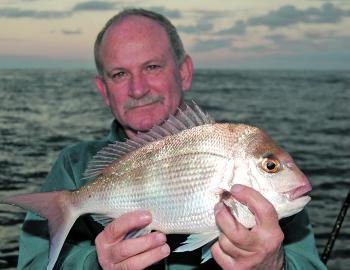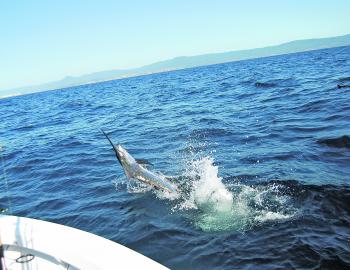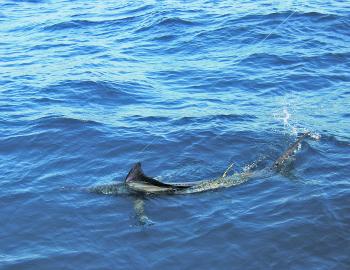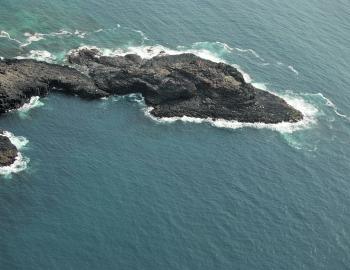Christmas is done and dusted. For many, now is holiday time with plenty of days to hit the water and get amongst the big ones. The offshore scene this month is always looked upon with great anticipation, as it generally sets the pattern for the rest of the summer. If the hot water shows late or the pelagics like marlin and mahimahi are slow off the mark, it can mean a short season. If they hit with a bang in numbers, all will be good for weeks to come.
Unlike last year, the striped marlin have been a bit slow over the past few weeks. With a push of warmer water, the luderick could show up and get things going. We can expect them from New Years day onwards, but the major action is later in the month when all the reefs along the coast fire. As always, places like Bandit Reef, Wollongong Reef and the reefs off Shell Harbour have schools of bait – the main targets.
A few stragglers will always be about, so it always pays to have that live slimy or yellowtail out swimming, no matter where or how you’re fishing. They can pop up anywhere. Without a bait in the water, you don’t stand a chance.
With the first clean bluewater that pushes down the coast, mahimahi arrive. The ones that sit on the front of the current are usually big. They pass through and small fish take up residence on every FAD and marker all along the coast before a few bigger fish move in later. They are extremely popular these days with boats jostling for positions on the FADs often at speed, throwing lures and baits and generally making a lot of noise.
These are the days to find something else to chase, as they go off the bite very quickly in these conditions. Live baits are generally the only thing that will attract any interest and often this is only fleeting. On a quieter day, the same live baits will be attacked the moment they hit the water and the games begin.
For bigger fish, grab the biggest slimy mackerel or yellowtail you can get. They can take a bit of punishment from the smaller fish, allowing the bigger fish to have a go. The bigger fish get well educated very quickly and become cautious in heavily fished locations, so they often sit quite a distance from the FAD. Don’t be too hasty in getting back to the mark.
There are apex predators around when there are lots of smaller fish on the FAD, so the live bait has every chance of attracting a marlin as well as a big dolly. The boats chasing marlin out wide are picking up a few yellowfin, but they have been patchy and only smaller fish up to 20kg+ with the odd larger fish show from time to time. It’s better than none at all. The odd spearfish has been about with some albacore too.
Striped tuna are out there as well, so the snapper bait can be topped up while chasing the bigger fish. Snapper are a bit quiet in over the shallow reefs at the moment, as they seem to be in the deeper water of 40-50m. They’re easy enough to get until a bit of current shows up, then it will be tough in the deeper water. You chase kings then.
In close, the kings have been fairly active – they need that current to really get them going. Until then, live baits down rigged in most of the recognised close spots like the islands, Bass Point and Rangoon are all worth a look. The outer reefs have bigger fish using the same method and knife jigs. They’re hard work if there isn’t any current.
Fish to 12kg can be expected with the majority between 3-5kg. Other pelagics have been a little less finicky with salmon schooling all along the coast. Look for the birds or the ripples and chop on the ocean that looks out of place. Up around the national park north of Stanwell there seem to be better concentrations of fish, while the islands, Bass Point, Kiama, in close along Coniston and even North Beach in the centre of town hold schools, particularly after a big northeasterly.
Trevally are moving with the schools, bonito and lots of small kings in some areas. These can be a pest, as they are always faster than the other fish and fight hard, only to be released by most. If you spot someone taking undersized kings, call the fisheries hot line – it should always be in your phone – and give them the details. You might get lucky and they actually attend, so it’s worth a try. Grubs that take undersized fish are only destroying our future.
Not all the kings with the schools are small, so a live bait lobbed into the middle of a feeding school will usually get the attention of any bigger fish. It works well for any whopper sambos that may be there too. For the bottom fishos, the flathead have hit their straps and are over every patch of sand all along the coast. Some of the more northern spots cop a bit of work from the professionals, but there are still plenty of fish close to the edges of the reefs in these places.
Leatherjackets have been a bit of a pest but they are not anywhere near the numbers that they have been in past seasons. On the gravel edges and reef there have been good numbers of pan sized snapper and decent mowies to keep anglers busy. Pigfish, trevally and samsonfish are about as well. You may even get lucky and pick up a teraglin.
On the rocks, the southern deep ledges around Kiama will be the focus of attention as the LBG anglers hit the stones looking for that elusive marlin. Every year a few are hooked and the odd one is landed, but these ledges don’t get the angler traffic that the ledges down at Jervis Bay get. These days it’s getting harder and harder to fish the bay with all the restrictions, so the local spots are well worth putting some effort into. With a bit more effort, more fish will be hooked.
It’s not just marlin on the cards, as the big kings are about as well, along with bonito, salmon, frigates and the unavoidable sharks. For the rest of the coast, there are bream off most of the shallower headlands with a few trevally thrown in and some nice drummer. Most of the washes have luderick, as do the sheltered harbours in the early mornings after a solid northeasterly or southerly blow.
The northeasterlies also push bait into the northern breakwall at Port Kembla and the harbour entrance at Wollongong. At dawn, the salmon, bonito, frigates and kings get stuck into them. Lures get hit on every cast and it’s a lot of fun while it lasts. All the bait is cleaned up and the predators disperse.
The beaches are looking the goods with plenty of whiting on just about every beach, if you have fresh beach worms. Flathead are on all the beaches too with some nice bream in the corners near the rocks and the usual salmon and tailor in the early mornings and late evenings. With all this food about, there are mulloway on the prowl, from schoolies right up to fish of 20kg and better. Fresh bait on the top of the tide in the dark is the best option, but anytime you have a bait in the water you have a chance.
The estuaries are at their best with heaps of flathead all through the lake. Whiting are on all the shallow sand flats taking worms and nippers and if you are early enough, poppers. A few luderick are around the weed beds if you can get some good weed. Bream are in the feeder streams on the snags and around the bridge pylons at night. The prawns are around, but not in great numbers during the dark. There are plenty of blue swimmers all through the lake.
Minnamurra is much the same with nice flathead all along its length, whiting in the shallows and luderick along the weed edges, along with some big mullet and garfish on bread. Bream are around the pylons of the bridges. Remember there will be lots of people about, so plan your trip to avoid the crowds. Happy New Years.
Reads: 2904
There are plenty of pan-sized snapper over the inshore reefs this month.

Marlin are about this month not that far out from the coast.

This marlin from last season had already been tagged and had taken 20 days to get from Coffs Harbour to the Illawarra. He swam off with a new one.

Blowhole Point from the air – just one of the prime LBG spots in the area.




